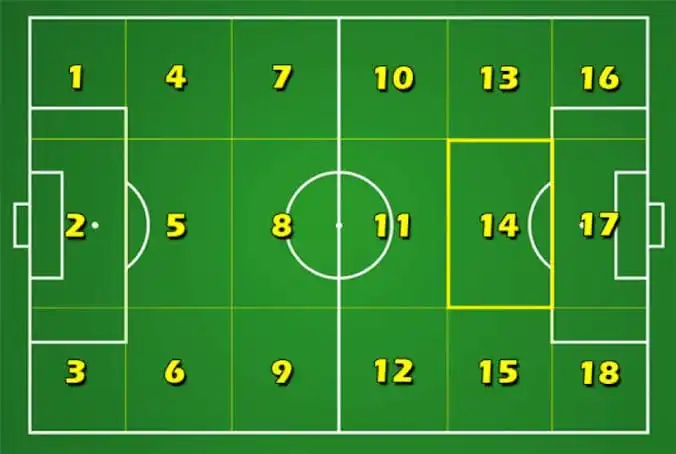In modern football analysis, spatial awareness has become a cornerstone of tactical planning. Among all the areas on the pitch, Zone 14 consistently emerges as a critical location for creating goal-scoring opportunities. But what exactly is this space, and why is it so important?
What Is Zone 14?
Zone 14 is a tactical concept that stems from dividing the pitch into a 6×3 grid, creating 18 rectangular zones across the field. This spatial division helps analysts and coaches better understand where decisive moments in football occur.
Zone 14 specifically refers to the central area just outside the penalty box, located between the two half-spaces in front of the goal. If you imagine a rectangle that starts at the top of the penalty area and extends about 10–15 meters toward the halfway line, that’s Zone 14.

Why Zone 14 Matters
The idea of Zone 14 rose to prominence through research by Taylor et al. (2002), who analyzed patterns leading to goals in elite matches. They discovered that entries and actions originating from Zone 14 correlated strongly with high-quality goal-scoring chances. Here’s why:
1. Centrality = Threat
Because Zone 14 is directly in front of goal, any successful action—whether it’s a pass, dribble, or shot—forces the defense to react. Central areas demand more attention from defenders, often drawing multiple players and creating space elsewhere.
2. Multiple Options
From Zone 14, players can:
- Shoot directly at goal.
- Slip through balls into the box.
- Switch play to the flanks.
- Combine in tight spaces.
This diversity makes the zone tactically rich. It’s not just a shooting area—it’s a decision-making hub.
3. Breaking Defensive Blocks
Compact defensive structures (low or mid-blocks) aim to deny central access. A team that finds a way into Zone 14 is often rewarded with broken lines and disorganization in the opposition’s shape.
4. High xG Pass Origins
In Expected Goals (xG) models, passes that originate from Zone 14 and reach players inside the box often result in high xG values. In other words, passes from this zone are statistically more likely to lead to goals.
Zone 14 in Tactical Systems
Different systems use Zone 14 in different ways:
- 1-4-2-3-1 formations often rely on the attacking midfielder (the “10”) to operate here.
- Pep Guardiola’s Manchester City frequently use positional play to open up Zone 14 before delivering killer passes.
- Counter-attacking teams aim to reach Zone 14 quickly after turnovers, capitalizing on defensive imbalance.
Zone 14 and Player Profiles
Not all players are equally effective in Zone 14. This area demands:
- Vision and passing accuracy
- Composure under pressure
- Spatial awareness
- Tight ball control
Think of players like Kevin De Bruyne, Bruno Fernandes, or Lionel Messi—players who excel at delivering final balls or striking from just outside the area.
Defending Zone 14
From a defensive standpoint, protecting Zone 14 is a key priority. Many teams use a double pivot in midfield to screen access to this zone. Others rely on compact lines and aggressive pressing the moment the ball enters that space.
However, even the best defensive blocks can be manipulated with movement from half-spaces or overlapping fullbacks, which stretch defenses horizontally and open up vertical lanes into Zone 14.
Zone 14 in Data Analysis
Zone 14 is a central focus in video and data scouting:
- Coaches monitor touches, progressive passes, and xThreat values from this area.
- Analysts track how often a team enters Zone 14 per game and the outcomes of those actions.
- Scouting reports often highlight how effectively a player or team can utilize or defend this space.
Conclusion
Zone 14 may only be one of eighteen zones on the pitch, but its importance far outweighs the others. It’s the launchpad for decisive passes, the hotspot for creative midfielders, and the space that often separates a sterile attack from a goal-scoring opportunity.
Understanding how to access, control, and defend Zone 14 is key for both players and coaches aiming for success at the highest levels.

Good staff